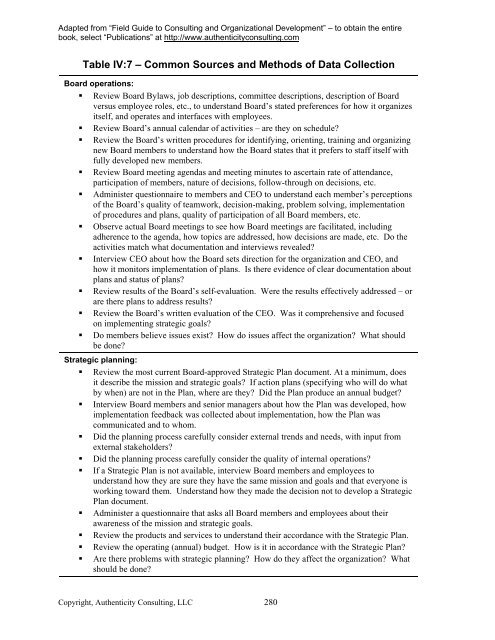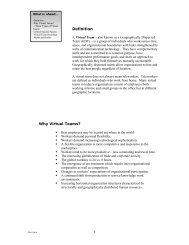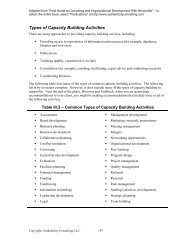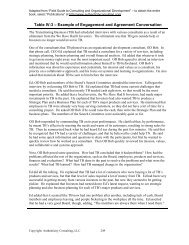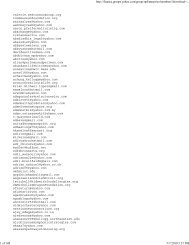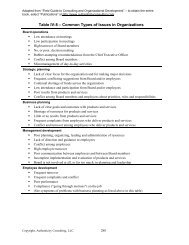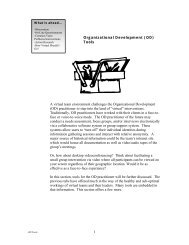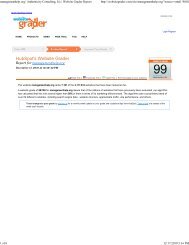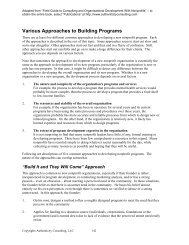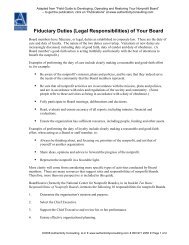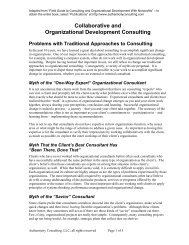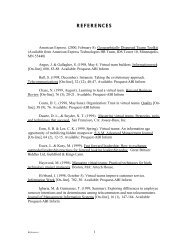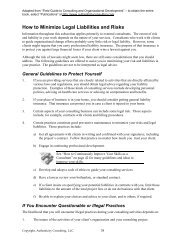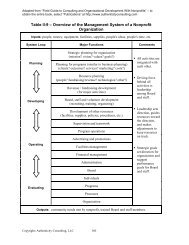Some Sources of Data and Methods to Collect that Data
Some Sources of Data and Methods to Collect that Data
Some Sources of Data and Methods to Collect that Data
You also want an ePaper? Increase the reach of your titles
YUMPU automatically turns print PDFs into web optimized ePapers that Google loves.
Adapted from “Field Guide <strong>to</strong> Consulting <strong>and</strong> Organizational Development” – <strong>to</strong> obtain the entire<br />
book, select “Publications” at http://www.authenticityconsulting.com<br />
Table IV:7 – Common <strong>Sources</strong> <strong>and</strong> <strong>Methods</strong> <strong>of</strong> <strong>Data</strong> <strong>Collect</strong>ion<br />
Board operations:<br />
• Review Board Bylaws, job descriptions, committee descriptions, description <strong>of</strong> Board<br />
versus employee roles, etc., <strong>to</strong> underst<strong>and</strong> Board’s stated preferences for how it organizes<br />
itself, <strong>and</strong> operates <strong>and</strong> interfaces with employees.<br />
• Review Board’s annual calendar <strong>of</strong> activities – are they on schedule?<br />
• Review the Board’s written procedures for identifying, orienting, training <strong>and</strong> organizing<br />
new Board members <strong>to</strong> underst<strong>and</strong> how the Board states <strong>that</strong> it prefers <strong>to</strong> staff itself with<br />
fully developed new members.<br />
• Review Board meeting agendas <strong>and</strong> meeting minutes <strong>to</strong> ascertain rate <strong>of</strong> attendance,<br />
participation <strong>of</strong> members, nature <strong>of</strong> decisions, follow-through on decisions, etc.<br />
• Administer questionnaire <strong>to</strong> members <strong>and</strong> CEO <strong>to</strong> underst<strong>and</strong> each member’s perceptions<br />
<strong>of</strong> the Board’s quality <strong>of</strong> teamwork, decision-making, problem solving, implementation<br />
<strong>of</strong> procedures <strong>and</strong> plans, quality <strong>of</strong> participation <strong>of</strong> all Board members, etc.<br />
• Observe actual Board meetings <strong>to</strong> see how Board meetings are facilitated, including<br />
adherence <strong>to</strong> the agenda, how <strong>to</strong>pics are addressed, how decisions are made, etc. Do the<br />
activities match what documentation <strong>and</strong> interviews revealed?<br />
• Interview CEO about how the Board sets direction for the organization <strong>and</strong> CEO, <strong>and</strong><br />
how it moni<strong>to</strong>rs implementation <strong>of</strong> plans. Is there evidence <strong>of</strong> clear documentation about<br />
plans <strong>and</strong> status <strong>of</strong> plans?<br />
• Review results <strong>of</strong> the Board’s self-evaluation. Were the results effectively addressed – or<br />
are there plans <strong>to</strong> address results?<br />
• Review the Board’s written evaluation <strong>of</strong> the CEO. Was it comprehensive <strong>and</strong> focused<br />
on implementing strategic goals?<br />
• Do members believe issues exist? How do issues affect the organization? What should<br />
be done?<br />
Strategic planning:<br />
• Review the most current Board-approved Strategic Plan document. At a minimum, does<br />
it describe the mission <strong>and</strong> strategic goals? If action plans (specifying who will do what<br />
by when) are not in the Plan, where are they? Did the Plan produce an annual budget?<br />
• Interview Board members <strong>and</strong> senior managers about how the Plan was developed, how<br />
implementation feedback was collected about implementation, how the Plan was<br />
communicated <strong>and</strong> <strong>to</strong> whom.<br />
• Did the planning process carefully consider external trends <strong>and</strong> needs, with input from<br />
external stakeholders?<br />
• Did the planning process carefully consider the quality <strong>of</strong> internal operations?<br />
• If a Strategic Plan is not available, interview Board members <strong>and</strong> employees <strong>to</strong><br />
underst<strong>and</strong> how they are sure they have the same mission <strong>and</strong> goals <strong>and</strong> <strong>that</strong> everyone is<br />
working <strong>to</strong>ward them. Underst<strong>and</strong> how they made the decision not <strong>to</strong> develop a Strategic<br />
Plan document.<br />
• Administer a questionnaire <strong>that</strong> asks all Board members <strong>and</strong> employees about their<br />
awareness <strong>of</strong> the mission <strong>and</strong> strategic goals.<br />
• Review the products <strong>and</strong> services <strong>to</strong> underst<strong>and</strong> their accordance with the Strategic Plan.<br />
• Review the operating (annual) budget. How is it in accordance with the Strategic Plan?<br />
• Are there problems with strategic planning? How do they affect the organization? What<br />
should be done?<br />
Copyright, Authenticity Consulting, LLC 280
Adapted from “Field Guide <strong>to</strong> Consulting <strong>and</strong> Organizational Development” – <strong>to</strong> obtain the entire<br />
book, select “Publications” at http://www.authenticityconsulting.com<br />
Table IV:7 – Common <strong>Sources</strong> <strong>and</strong> <strong>Methods</strong> <strong>of</strong> <strong>Data</strong> <strong>Collect</strong>ion (Cont.)<br />
Teamwork:<br />
• Review Personnel Policies <strong>to</strong> underst<strong>and</strong> how employees are supposed <strong>to</strong> be hired,<br />
assigned performance goals, rewarded <strong>and</strong> compensated for performance, <strong>and</strong> how<br />
performance issues are addressed.<br />
• Review the Organization Chart <strong>to</strong> underst<strong>and</strong> the roles in the organization <strong>and</strong> how those<br />
roles are integrated.<br />
• Review job descriptions. Do they have specific up-<strong>to</strong>-date responsibilities in accordance<br />
with the latest Strategic Plan?<br />
• Review written status reports about what each role does. Do the activities on the reports<br />
match the nature <strong>of</strong> work on the job descriptions?<br />
• Interview <strong>to</strong>p-level managers <strong>to</strong> underst<strong>and</strong> what teams exist, <strong>and</strong> the charter for each<br />
(charter specifies purpose <strong>and</strong> specific objectives <strong>of</strong> each team).<br />
• Administer a questionnaire about organizational climate, including respect, morale <strong>and</strong><br />
coordination <strong>of</strong> employees.<br />
• Observe staff meetings. Are they facilitated <strong>to</strong> an agenda? Are actions <strong>and</strong> issues<br />
recognized <strong>and</strong> addressed? Meeting minutes issued?<br />
• Interview various supervisors <strong>to</strong> underst<strong>and</strong> how tasks are assigned, decisions are made,<br />
conflict is managed <strong>and</strong> communication occurs among individual employees.<br />
• Examine the rate <strong>of</strong> employee turnover, etc. Are activities in accordance with Personnel<br />
Policies?<br />
• Do people believe <strong>that</strong> issues exist? How do issues affect the rest <strong>of</strong> the organization?<br />
What should be done?<br />
Financial management:<br />
• Review the current annual operating budget. Does it reflect priorities from the most<br />
recent Strategic Plan?<br />
• Review current <strong>and</strong> past year’s financial statements, including the income statement <strong>and</strong><br />
balance sheet. Is there a budget-versus-actual <strong>and</strong>/or cash flow report? Are they<br />
complete? How <strong>of</strong>ten were they issued? Who reviews them <strong>and</strong> how?<br />
• Review the fiscal policies <strong>and</strong> procedures. Do they ensure accurate <strong>and</strong> legal collection,<br />
control <strong>and</strong> disbursement <strong>of</strong> funds?<br />
• Review the latest financial audit from an outside audi<strong>to</strong>r. Are all accounting st<strong>and</strong>ards<br />
followed? Are the audi<strong>to</strong>r’s recommendations followed?<br />
• Interview Board members. What do they know about reviewing financial information?<br />
How are they sure the information is accurate?<br />
• Interview the Board Treasurer. How are finances tracked <strong>and</strong> analyzed?<br />
• Interview the bookkeeper. How are transactions entered <strong>and</strong> statements generated? To<br />
whom do they go? What do others do with them?<br />
• Interview personnel regarding products <strong>and</strong> services. How were pricing policies<br />
established?<br />
• Interview the CEO or Board Treasurer. How do they know there are sufficient funds <strong>to</strong><br />
pay current bills?<br />
• Do people perceive <strong>that</strong> there are issues in financial management? How do issues affect<br />
the rest <strong>of</strong> the organization? What should be done?<br />
Copyright; Authenticity Consulting, LLC 281
Adapted from “Field Guide <strong>to</strong> Consulting <strong>and</strong> Organizational Development” – <strong>to</strong> obtain the entire<br />
book, select “Publications” at http://www.authenticityconsulting.com<br />
Table IV:7 – Common <strong>Sources</strong> <strong>and</strong> <strong>Methods</strong> <strong>of</strong> <strong>Data</strong> collection (Cont.)<br />
Business planning for each product or service:<br />
• Review each Business Plan. Does it describe the product or service, target markets,<br />
management for the product or service, how it will be marketed <strong>and</strong> financials?<br />
• Interview managers about how each Plan was developed, how implementation feedback<br />
was collected about implementation, <strong>and</strong> how the Plan was communicated <strong>and</strong> <strong>to</strong> whom.<br />
• If a Plan does not exist, are key members <strong>of</strong> the Board <strong>and</strong> the managers aware <strong>of</strong> all <strong>of</strong><br />
the information <strong>that</strong> should be in a Plan?<br />
• Did the planning process include careful market research <strong>to</strong> clarify needs <strong>and</strong> wants <strong>of</strong><br />
various, specific target markets?<br />
• Did the planning process include careful market research <strong>to</strong> verify <strong>that</strong> the product or<br />
service will indeed match the needs <strong>and</strong> wants <strong>of</strong> its particular target markets?<br />
• Does information about management indicate <strong>that</strong> there is sufficient expertise <strong>to</strong> obtain<br />
<strong>and</strong> organize resources so <strong>that</strong> the product or service will be developed <strong>and</strong> will sell well?<br />
• Did the planning process include careful analysis <strong>of</strong> the financials, including costs <strong>to</strong><br />
develop <strong>and</strong> sell the product or service, along with expected revenues <strong>and</strong> any plans <strong>to</strong><br />
address any near-term deficits?<br />
• Do people believe there are issues with business planning? How do issues affect<br />
organization? What should be done?<br />
Advertising <strong>and</strong> promotion for each product or service, <strong>and</strong> overall public relations<br />
• Review plans for advertising <strong>and</strong> promotions. Do they describe the target markets for<br />
each product or service, the needs <strong>and</strong> wants <strong>of</strong> each target, styles <strong>of</strong> communications<br />
preferred by each target, <strong>and</strong> how the features <strong>and</strong> benefits <strong>of</strong> each product or service are<br />
communicated <strong>to</strong> the target.<br />
• Interview managers about how each plan was developed, how implementation feedback<br />
was collected about implementation, <strong>and</strong> how the plans were communicated <strong>and</strong> <strong>to</strong><br />
whom.<br />
• Interview managers <strong>to</strong> underst<strong>and</strong> who is responsible for advertising <strong>and</strong> promotions?<br />
Are plans being implemented on schedule? If not, why not? What can be done <strong>to</strong> make<br />
the plans more useful?<br />
• Interview several major cus<strong>to</strong>mers. What do they think <strong>of</strong> the organization? How could<br />
advertising <strong>and</strong> promotions be more effective?<br />
• If plans do not exist, are key members <strong>of</strong> the Board <strong>and</strong> the managers aware <strong>of</strong> all <strong>of</strong> the<br />
information <strong>that</strong> should be in plans for advertising <strong>and</strong> promotions?<br />
• Do people believe there are issues with advertising <strong>and</strong> promotions? How do those issues<br />
affect rest <strong>of</strong> organization? What should be done?<br />
Fill in the “Planning the Research” Worksheet<br />
If you <strong>and</strong> your client are planning the research now, then in the<br />
worksheet, “Planning the Research,” in Appendix C, fill in the section,<br />
“<strong>Data</strong> collection method(s).”<br />
Copyright, Authenticity Consulting, LLC 282


